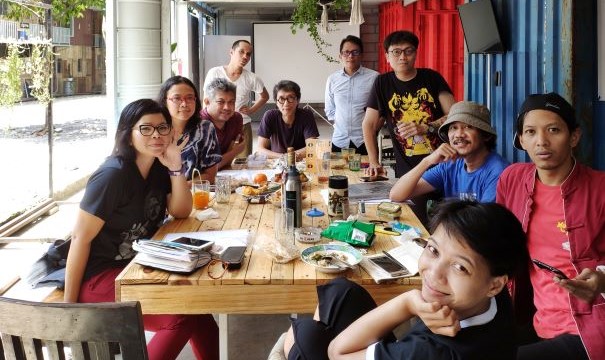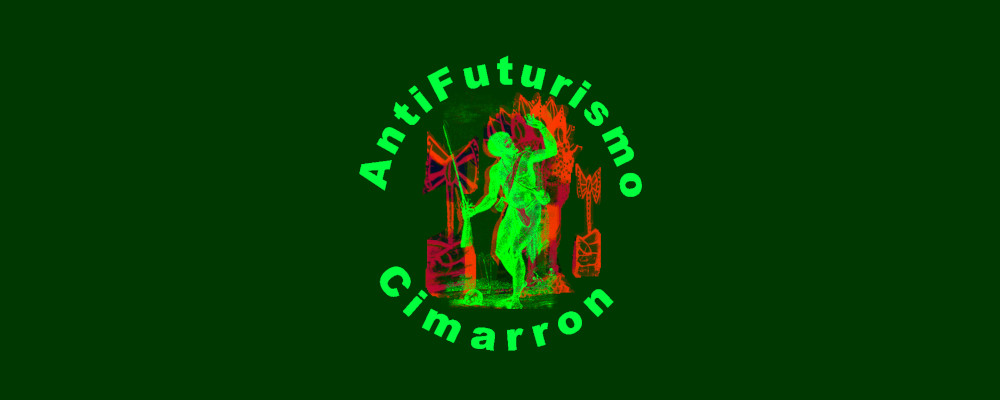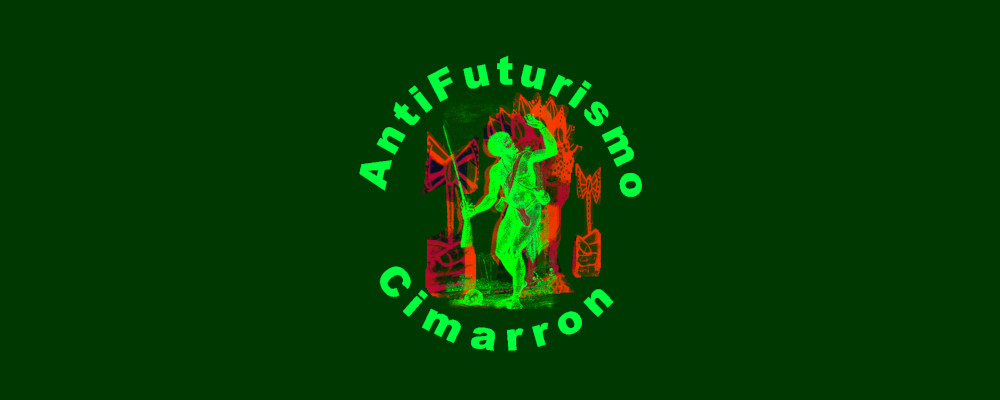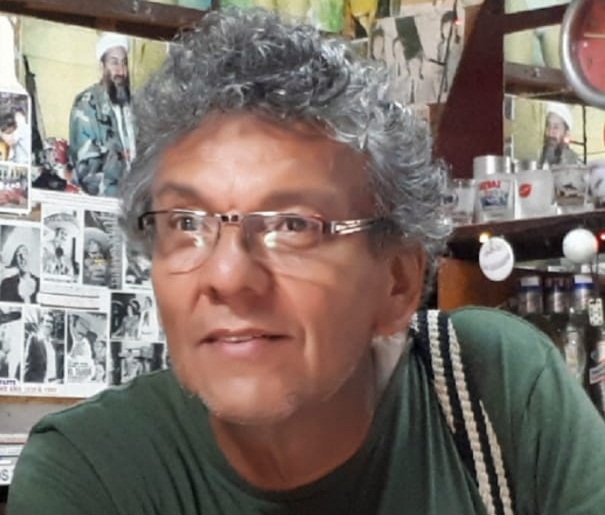THE FUTURE IS GONE: CIMARRÓN ANTI-FUTURISM
Seminar-Laboratory
16.10.2021 – 15.10.2022
The project of the collaborative and expository exhibition The future is gone: Cimarron Anti-Futurism, with the curandería* of Yuderkys Espinosa-Miñoso and Katia Sepúlveda, invites a group of previously selected individual and collective activist and community artists to be part of a process of collective creation based on using their experiences and enunciative positions to reflect on a series of texts and contexts that hopefully announce the disappearance of Europe and its world project based on the conquer ego.
The entire process involves a year-long theoretical and practical seminar/laboratory with virtual sessions once a month in which we will reflect, debate and imagine based on the questions What would the world be like if Europe (as a trope) disappeared? What would it be like if it had never existed? How has time been experienced outside the historical time of European modernity?
For this we will use a series of previously selected texts and creative works, in addition to the contributions that the context and experience of each participant/creator bring to the collective space. The methodology is sufficiently open to events and to surprise. We propose to make work meetings a space for encounter, recognition and thinking in mutual relation.
At the same time as these meetings are held, the participating artists will be thinking, feeling, imagining, experimenting and producing their own work and helping to create a collective work that will be the result of the entire process of accompaniment and conversation. Each work session will thus be a creative laboratory in which artists will share and accompany each other in the different stages of design and creation of their works and of the collective work. The methodology of each meeting includes exercises in energy attunement, group reading and discussion, creative exercises and exercises of experimentation with another language in addition to writing.
This exhibition and research project is a co-production of La Virreina Centre de la Imatge and Arts Santa Mònica.
List of artists:
Joiri Minaya (Dominican Republic / United States) Multidisciplinary Dominican-American artist whose work investigates the female body within constructions of identity, multicultural social spaces and hierarchies. Born in New York, she grew up in the Dominican Republic and graduated from the National School of Visual Arts, Santo Domingo, Dominican Republic (2009), the Altos de Chavón School of Design (2011) and the Parsons School of Design (2013).
Verena Melgarejo (Bolivia / Germany) is an artist, curator, educator and researcher who studied at the Academy of Fine Arts Vienna and the Universidad Nacional de Bellas Artes in Buenos Aires. She works with video-and photo-performance and installations, using textile as an instrument to incorporate manual knowledge in the artistic process. In often ritualistic formats she uses her body and her (ancestral) history as tools to address colonial and patriarchal structures and search for ways of individual and collective healing for what she calls “arte-sana”. Her works have been exhibited at the Museo de Arte Contemporaneo in Salta, Argentina, at the nGbk Berlin in Germany, at the Wiener Festwochen Art Festival in Austria and at the BIENIALSUR in Cúcuta, Colombia.
Yelaine Rodríguez (Dominican Republic / United States) Afro-Dominican artist, educator, curator and cultural organizer from the United States. She graduated from the New School (2013) and earned a master's degree from New York University (2021). Rodríguez conceptualizes the art of clothing and site-specific installations, drawing connections between the black cultures of the Caribbean and the United States through fashion, video, performance and photography. Her interfaith and international narratives examine identity and race.
Marcela Huitraiqueo (Wallmapu, Chile) is a visual artist of Mapuche origin. She lives in Lof Wete Rukan, near Temuco, so her work has been highly influenced by the stories of her community. In her creative practice, she tries to fix an image, a narrative that corresponds to the conservation of these more traditional ancestral memories. She works on large-format painting with immense expressiveness, which she calls “pictorial carvings”. The Mapuche way of being, their land and their people unfold through a powerful and challenging pictorial work that places her within a new generation of artists who strive to defend their ancestral culture.
Johanné Gómez Terrero (Dominican Republic) Filmmaker but not only, graduated from the International Film and TV School in San Antonio de los Baños, Cuba, and from the Cinema and Audiovisual School of Catalonia. Her most recent works include the documentary Caribbean Fantasy, winner of awards such as the Coral Prize of the Havana Festival, La Silla in the Dominican Republic, Cinepoeme at DocsMX, the Best Research award in Nador, Morocco, and a special mention from the jury at MiradasDoc in Tenerife.
Katia Sepúlveda (Chile / Germany) Katia Sepúlveda began attending workshops run by Chilean artists at the age of 15. Between 1996 and 2000 she studied photography at the ARCOS Institute of Arts and Communication in Santiago de Chile, followed by a postgraduate course in film directing at the University of Chile. In order to further improve her graphic printing techniques, she took classes at Taller 99. Upon receiving a DAAD arts scholarship, she moved to Germany in 2004 to study at the Cologne Academy of Arts and Media, where she attended classes by Valie Export, Jürgen Klauke, Matthias Müller and Julia Scher. The framework of her works addresses critical and decolonial feminisms. In 2006, she began her master’s degree with a Rosa Luxemburg Foundation grant at the Cologne Academy of Arts and Media, where she finished her studies in early 2009. She is currently pursuing a doctorate in critical theory at 17, Institute of Critical Studies in Mexico City. She was a Selected Artist at the 32nd Sao Paulo Biennial and her work has been exhibited at MASP in Sao Paulo and in other countries worldwide. She lives and works in Cologne, Germany.
Ayllu Collective (Ecuador, Chile, Argentina, Venezuela and Madrid, Spain) Collaborative group of artistic/political research and action made up of migrant and racialized sexual and gender dissidents from ex-colonies. The group proposes a critique of whiteness as a European colonial heteronormative ideology, and a critique of the global project of multicultural cities. These function as an ornamental and symbolic strategy that instrumentalizes migration and refugee status as a smokescreen to conceal neoliberal businesses, NGOs, the human rights industry and the entire heteronormative racist structure of the laws of the Spanish State.
Daniela Ortiz (Peru) Through her work she aims to generate visual narratives in which the concepts of nationality, racialization, social class and gender are understood critically in order to analyse colonial, capitalist and patriarchal power. Her recent projects and research address the European migration control system, its link with colonialism, and the legal mechanisms created by European institutions to exercise violence against migrant and racialized populations. She has also carried out various projects on the Peruvian upper class and their exploitative relationship with domestic workers. Recently, her artistic work has returned to a visual and manual focus through works in ceramics, collage, drawing and formats such as children’s books with the aim of moving away from Eurocentric conceptual aesthetics. In addition to her artistic work, she is the mother of a three-year-old Waawa girl, she gives talks and workshops, and she participates in discussions and struggles against the European immigration control system and institutional racism.
Naomi Rincón Gallardo (Mexico / United States) Visual artist and cultural worker. She lives and works in Mexico City. From a cuir decolonial perspective, her work produces counterworlds driven by desire and disobedience in the face of contemporary heteropatriarchal dispossession in neocolonial contexts. In a practice that she describes as “mythical-political surrealism”, Rincón combines her interest in Mesoamerican epistemes, speculative fiction, music videos, theatrical games, vernacular festivities and manual creation of props and costumes. She completed her undergraduate studies at the La Esmeralda National School of Painting, Sculpture and Engraving, obtained a master’s degree in the programme Education: Culture, Language and Identity from Goldsmiths, University of London, and has a PhD in Practice Programme from the Academy of Fine Arts in Vienna.
Evel Romain (Haiti) Member of the collective of artists known as Atis Rezistans and a broader movement known as the Sculptors of La Grand Rue, and he trained with Jean Hérard Celeur. Much of Evel’s work reflects his African heritage with his use of minimal forms and string details. Evel has been a participant and organizer of the Ghetto Biennale since its inception in 2009.
Ajchowen (Guatemala) Ajchowen (“artist” or “one who makes art” in the Kaqchikel language) is a collective of Mayan women composed of seven actress-dancers and an Ajq’ij (timekeeper). They are from the K’iche’, Kaqchickel and Mam Mayan linguistic communities and are accompanied by a mestizo man, Víctor Barillas, who is the playwright and stage director. To date they have three collective theatrical works and eight individual monologues. Their works are based on the principles and values of the Mayan world view. Their aim is to heal consciousness, promote the culture, struggle and empowerment of Mayan women, and denounce social problems in their context. They have presented their works at national and international theatre festivals and in various organizations and communities.
Imayna Caceres (Peru) The work of Imayna Caceres as an artist and activist grows through collaborative research with non-human entities and local ecosystems and in response to spiritual and ecopolitical concerns. It includes drawing, painting, encounters, ritual practices, projects in public spaces, digital drawing and video. She is interested in community practices and relates to different forms of knowledge to the hegemonic ones. She lives and works near the banks of the River Danube and forms part of the Trenza and Antikoloniale Interventionen collectives in Vienna, which are organized around ecofeminist issues. She has a degree in Fine Arts and in Artistic and Cultural Sciences and a degree in Sociology and Communication Sciences, and she is currently preparing a PhD in Philosophy at the Academy of Fine Arts Vienna.
Yoel Diaz Vazquez (1973, Havana) is an artist of Cuban origin whose work has been shown in numerous exhibitions all over the world. He has lived and worked in Berlin since 2006. He graduated as a sculptor from the San Alejandro Academy of Fine Arts in Havana in 1997 and as a video editor and videographer from the SAE Institute in Berlin in 2014. Diaz Vazquez’s practice spans various media, including sculpture, drawing, photography, video and installations. His work explores individual and collective responses to the questioning of power, as well as the symbolic imaginary of their social and political contexts.
Nitzayra Leonor (Puerto Rico) is a multidisciplinary artist who works in engraving, photography, the body and ceramics to develop a plastic language based on her experience, memory and identity as a black, afro-descendant, Puerto Rican and Caribbean woman. She studied for a bachelor's degree in Fine Arts and took specialized courses in Sculpture and Engraving at the School of Plastic Arts and Design of Puerto Rico.
Helen Ceballos (Dominican Republic / Puerto Rico) I was born in the Caribbean of the 1980s. I’m a cross-border performance artist, a self-taught photographer and video artist. I left home at the age of fourteen and I’ve lived in eleven cities, seven countries and thirty-five houses. I’ve moved house more than once for every year I’ve lived, and moves are in fact one of the most frequent thematic lines in my work.I’ve worked with notions and concepts on the decolonization of the body, artivism, the physical and conceptual space of borders, moves, politics, scatology, ritual, eroticism, the inframince, esotericism and queerness. I base my work on my afro-descendant, migrant body and its transitions as triggers of sign and meaning. I see the performative instances that I design as consequences of my daily life. There’s a great deal of truth, and also a great deal of a truth made fiction. The photographic work that I do is the conceptual territory where my contradictions come together. It’s a boiling pot for languages that approach the theatrical, the plastic and the performative. From this fusion, I am.
*We use the concept “curanderismo” in line with the idea of Gloria Anzaldúa, who takes up the spiritual tradition of the Aztec people, seeing art as a process that creates a reality that, like the shaman or healer, heals the colonial wound and therefore serves the purposes of decolonization.














